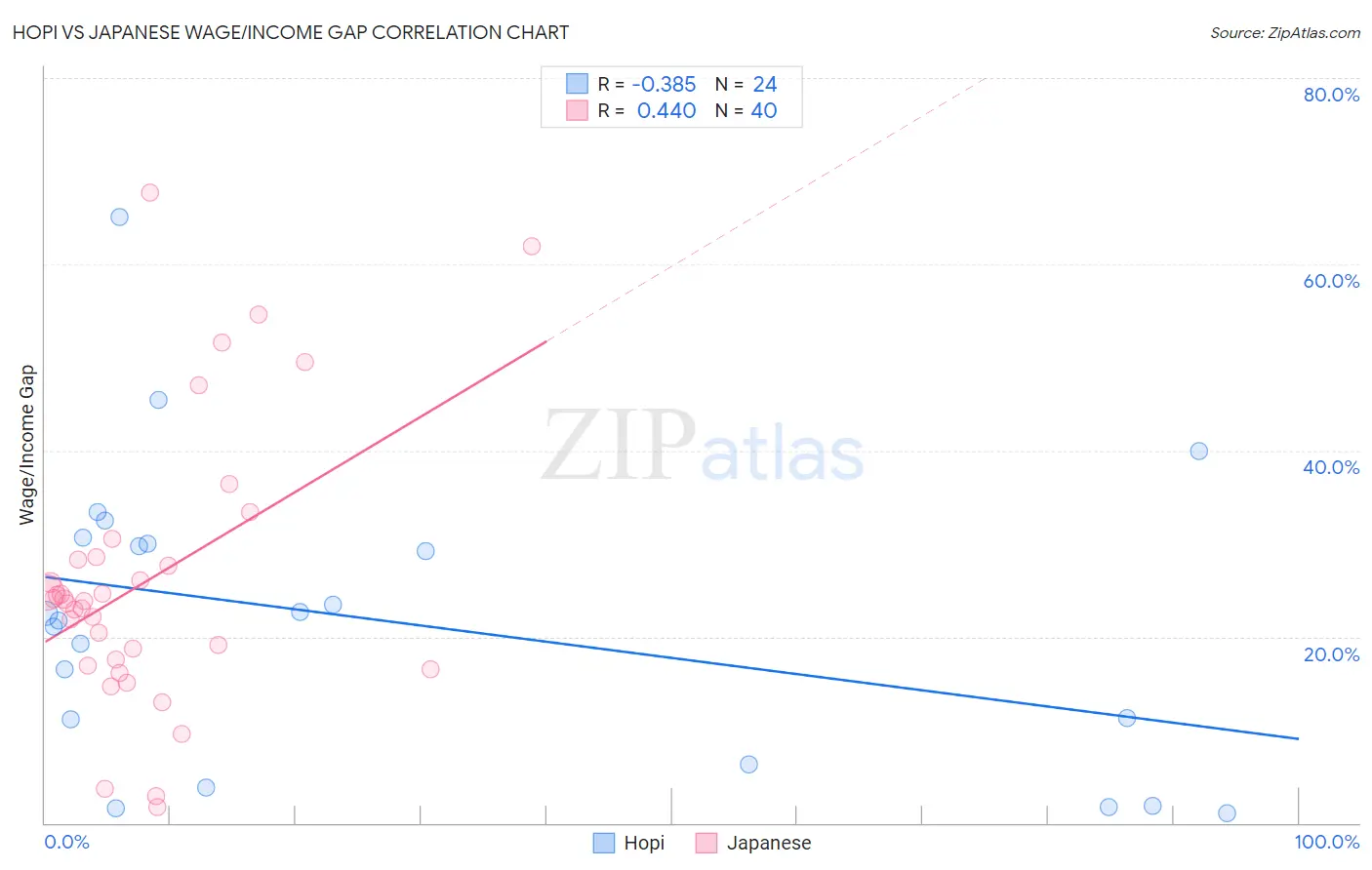Hopi vs Japanese Wage/Income Gap
COMPARE
Hopi
Japanese
Wage/Income Gap
Wage/Income Gap Comparison
Hopi
Japanese
20.0%
WAGE/INCOME GAP
100.0/ 100
METRIC RATING
18th/ 347
METRIC RANK
23.8%
WAGE/INCOME GAP
99.1/ 100
METRIC RATING
101st/ 347
METRIC RANK
Hopi vs Japanese Wage/Income Gap Correlation Chart
The statistical analysis conducted on geographies consisting of 74,717,570 people shows a mild negative correlation between the proportion of Hopi and wage/income gap percentage in the United States with a correlation coefficient (R) of -0.385 and weighted average of 20.0%. Similarly, the statistical analysis conducted on geographies consisting of 249,130,971 people shows a moderate positive correlation between the proportion of Japanese and wage/income gap percentage in the United States with a correlation coefficient (R) of 0.440 and weighted average of 23.8%, a difference of 18.9%.

Wage/Income Gap Correlation Summary
| Measurement | Hopi | Japanese |
| Minimum | 1.1% | 1.7% |
| Maximum | 65.0% | 67.8% |
| Range | 64.0% | 66.0% |
| Mean | 21.7% | 26.0% |
| Median | 22.1% | 23.9% |
| Interquartile 25% (IQ1) | 8.7% | 17.2% |
| Interquartile 75% (IQ3) | 30.3% | 28.4% |
| Interquartile Range (IQR) | 21.6% | 11.2% |
| Standard Deviation (Sample) | 15.8% | 14.8% |
| Standard Deviation (Population) | 15.5% | 14.6% |
Similar Demographics by Wage/Income Gap
Demographics Similar to Hopi by Wage/Income Gap
In terms of wage/income gap, the demographic groups most similar to Hopi are Immigrants from Dominica (20.0%, a difference of 0.060%), Bahamian (20.2%, a difference of 1.2%), Haitian (19.7%, a difference of 1.4%), Immigrants from Caribbean (20.4%, a difference of 1.9%), and Jamaican (19.6%, a difference of 2.2%).
| Demographics | Rating | Rank | Wage/Income Gap |
| Immigrants | Haiti | 100.0 /100 | #11 | Exceptional 19.2% |
| Immigrants | West Indies | 100.0 /100 | #12 | Exceptional 19.2% |
| Trinidadians and Tobagonians | 100.0 /100 | #13 | Exceptional 19.3% |
| Immigrants | Trinidad and Tobago | 100.0 /100 | #14 | Exceptional 19.3% |
| West Indians | 100.0 /100 | #15 | Exceptional 19.6% |
| Jamaicans | 100.0 /100 | #16 | Exceptional 19.6% |
| Haitians | 100.0 /100 | #17 | Exceptional 19.7% |
| Hopi | 100.0 /100 | #18 | Exceptional 20.0% |
| Immigrants | Dominica | 100.0 /100 | #19 | Exceptional 20.0% |
| Bahamians | 100.0 /100 | #20 | Exceptional 20.2% |
| Immigrants | Caribbean | 100.0 /100 | #21 | Exceptional 20.4% |
| Immigrants | Liberia | 100.0 /100 | #22 | Exceptional 20.6% |
| Immigrants | Dominican Republic | 100.0 /100 | #23 | Exceptional 20.6% |
| Dominicans | 100.0 /100 | #24 | Exceptional 20.6% |
| Senegalese | 100.0 /100 | #25 | Exceptional 20.7% |
Demographics Similar to Japanese by Wage/Income Gap
In terms of wage/income gap, the demographic groups most similar to Japanese are Immigrants from Laos (23.8%, a difference of 0.14%), Yakama (23.7%, a difference of 0.15%), Aleut (23.7%, a difference of 0.17%), Immigrants from Latin America (23.7%, a difference of 0.25%), and Tsimshian (23.9%, a difference of 0.37%).
| Demographics | Rating | Rank | Wage/Income Gap |
| Hondurans | 99.5 /100 | #94 | Exceptional 23.6% |
| Cape Verdeans | 99.4 /100 | #95 | Exceptional 23.6% |
| Kiowa | 99.4 /100 | #96 | Exceptional 23.6% |
| Immigrants | Sudan | 99.4 /100 | #97 | Exceptional 23.6% |
| Immigrants | Latin America | 99.2 /100 | #98 | Exceptional 23.7% |
| Aleuts | 99.2 /100 | #99 | Exceptional 23.7% |
| Yakama | 99.2 /100 | #100 | Exceptional 23.7% |
| Japanese | 99.1 /100 | #101 | Exceptional 23.8% |
| Immigrants | Laos | 99.0 /100 | #102 | Exceptional 23.8% |
| Tsimshian | 98.9 /100 | #103 | Exceptional 23.9% |
| Tlingit-Haida | 98.7 /100 | #104 | Exceptional 24.0% |
| Moroccans | 98.6 /100 | #105 | Exceptional 24.0% |
| Sudanese | 98.6 /100 | #106 | Exceptional 24.0% |
| Yaqui | 98.4 /100 | #107 | Exceptional 24.0% |
| Immigrants | Albania | 98.4 /100 | #108 | Exceptional 24.0% |